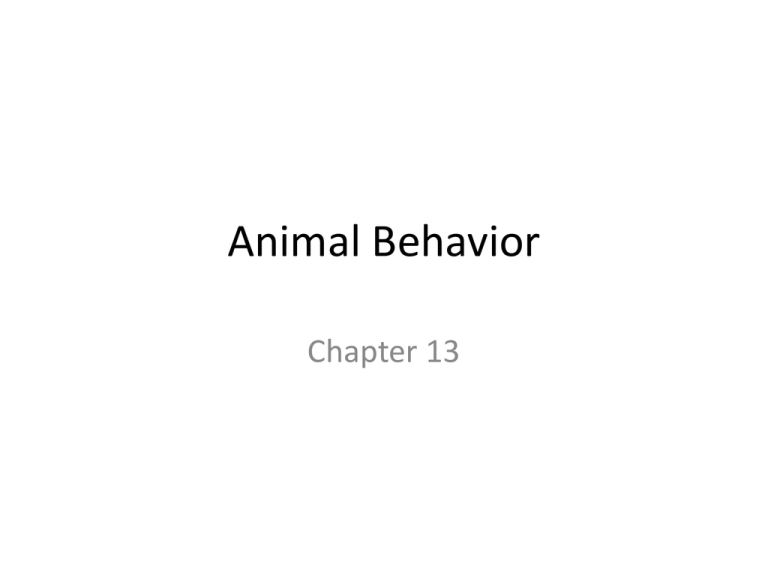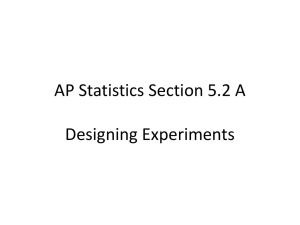Animal Behavior Ch 13 - Stephanie Dietterle Webpage
advertisement

Animal Behavior Chapter 13 Sec 1: What is Behavior? • The Behavior of Animals – An animals behavior consists of all the actions it performs – Examples: behaviors include actions an animal takes to obtain food, avoid predators, and find a mate – Like body structures the behaviors of animals are adaptations that have evolved over long periods of time Sec 1: What is Behavior? • The Behavior of Animals – Most behavior is a complex process in which different parts of an animals body work together – Think about what happens if a water current carries a small animal to a hydra’s tentacles. After stinging cells on the tentacles catch the prey, the tentacles bend toward the hydra’s mouth. At the same time, the hydra’s mouth opens to receive the food Sec 1: What is Behavior? • The Behavior of Animals – Behavior as Response • The touch of the prey on the tentacles acts as a stimulus to the hydra • A stimulus is a signal that causes an organism to react in some way • The organisms reaction to the stimulus is called a response • The hydra’s response to the prey is to sting it • All animal behaviors are caused by stimuli Sec 1: What is Behavior? • The Behavior of Animals – The Functions of Behavior • Most behaviors help an animal survive or reproduce • When an animal looks for food or hides to avoid a predator, it is doing something that helps it stay alive • When animals search for mates and build nests for their young, they are behaving in ways that help them reproduce Sec 1: What is Behavior? • Behavior by Instinct – Animals perform some behaviors by instinct, without being taught – An instinct is a response to a stimulus that is inborn and that an animal performs correctly the first time – Example: a newborn kangaroo instinctively crawls into its mother’s pouch and attaches itself to a nipple. Without this instinct, baby kangaroos could not obtain the milk they need to survive Sec 1: What is Behavior? • Learned Behavior – Learning is the process that leads to changes in behavior based on practice or experience – Learned behavior include imprinting, conditioning, trial-and-error learning, and insight learning – Cause learned behaviors result from an animals experience, they are not usually done perfectly the first time Sec 1: What is Behavior? • Learned Behavior – Imprinting: certain newly hatched birds and newborn mammals recognize and follow the first moving object they see (usually the mother) – Imprinting involves a combination of instinct and learning – The young animal has an instinct to follow a moving object, but is not born knowing what is parent looks like Sec 1: What is Behavior? • Imprinting – Once imprinting takes place, it cannot be changed – Imprinting is valuable for two reasons. First, it keeps young animals close to their mothers, who know where to find food and how to avoid predators – Second, imprinting allows young animals to learn what other animals of their own species look like – The ability protects the animals while they are young. In later life, this ability is important when the animals search for mates Sec 1: What is Behavior? • Learned Behavior – Conditioning: learning that a particular stimulus or response leads to a good or a bad outcome – Here is how the conditioning works: at first, a puppy rarely comes when you call. Each time the puppy comes when you call, you give it a dog biscuit. Your puppy will soon learn to associate the desired response – coming when called – with the good outcome of a food reward. To get the reward, the puppy learns to come every time you call. After a while, the puppy will come to you even if you don’t give it a dog biscuit Sec 1: What is Behavior? • Learned Behavior – Trail-and-Error Learning: an animal learns to perform a behavior more and more skillfully – Through repeated practice, an animal learns to repeat behaviors that result in rewards and avoid behaviors that result in punishment – Many animals learn by trial-and-error which methods are best for obtaining food – They also learn which methods to avoid • Example: snunk Sec 1: What is Behavior? • Learned Behavior – Insight Learning: when you solve a problem or learn how to do something new by applying what you already know, without a period of trial-anderror – Insight learning is most common in primates, such as gorillas, chimpanzees, and humans – Example: chimps use twigs to probe into the nests of termites and other insects that they eat Sec 2: Patterns of Behavior • Communication – Animals use mostly sounds, scents, and body movements to communicate with one another – An animals ability to communicate helps it interact with other animals – Animals communicate many kinds of messages using sound – Some animals use sound to attract mates • Example: female crickets, are attracted to the sound of a male’s chirping Sec 2: Patterns of Behavior • Communication – Animals may also communicate warnings with sound • Example: when a coyote or other predator approaching, a prairie dog makes a yipping sound that warns other prairie dogs to take cover in their burrows – Animals also communicate with chemical scents – A chemical release by one animal that affects the behavior of another animal of the same species is called a pheromone • Example: perhaps you have seen a male house cat spraying a tree, this scent advises other cats in the neighborhood of his presence Sec 2: Patterns of Behavior • Competitive Behavior – Animals compete with one another for limited resources, such as food, water, space, shelter, and mates – Competition can occur among different species of animals • Example: a pride of lions may try to steal a prey from a troop of hyenas that has just killed the prey – Competition can also occur between members of the same species Sec 2: Patterns of Behavior • Competitive Behavior – Showing Aggression • Aggression is a threatening behavior that one animal uses to gain control over another – Example: before a pride of lions settles down to eat its prey, individual lions show aggression by snapping, clawing, and snarling • Aggression between members of the same species hardly ever results in the injury or death of any of the competitors Sec 2: Patterns of Behavior • Competitive Behavior – Establishing a Territory • A territory is an area that is occupied and defended by an animal or group of animals • If another animal of the same species enters the territory, the owner will attack the newcomer and try to drive it away • Birds use songs and aggressive behaviors to maintain their territories • Other animals may use calls, scratches, droppings, or pheromones Sec 2: Patterns of Behavior • Competitive Behavior – Attracting a Mate • A male and female salamander swim gracefully in the water, moving around one another • Courtship behavior is a behavior in which males and females of the same species prepare for mating • Courtship behavior ensures that the males and females of the same species recognize one another, so that mating and reproduction can take place • Courtship behavior is typically also competitive – Example: in some species, several males may perform courtship behaviors for a single female. She then chooses one of them to mate with Sec 2: Patterns of Behavior • Group Behavior – Living in groups enables animals to cooperate – Although many animals live alone and only rarely meet one of their own kind, other animals live in groups – Some fishes form schools, and some insects live in large groups – Hoofed mammals, such as bison and wild horses, often form herds Sec 2: Patterns of Behavior • Group Behavior – Safety in Groups • Living in groups often protects animals against predators (fishes that swim in schools are often safer then fishes that swim alone) • Animals in a group sometimes cooperate in fighting off a predator – Example: Fig 13 p448 Sec 2: Patterns of Behavior • Group Behavior – Animal Societies • Some animals, including ants, termites, honeybees, naked mole rats, and pistol shrimp, living in groups called societies • A society is a group of closely related animals of same species that work together in a highly organized way • In a society, there is a division of labor – different individuals perform different tasks Sec 2: Patterns of Behavior • Behavior Cycles – Some animal behavior, called cyclic behaviors, occur in regular, predictable patterns – Cyclic behaviors usually change over the course of the day or a season Sec 2: Patterns of Behavior • Behavior Cycles – Daily Cycles • Behavior cycles that occur over a period of approximately one day are called circadian rhythms • For example, blowflies search for food during the day and rest at night • In contrast, field mice are active during the night and rest by day • Animals that are active during the day can take advantage of sunlight, which makes food easy to see • On the other hand, animals that are active at night do not encounter predators that are active during the day Sec 2: Patterns of Behavior • Behavior Cycles – Hibernation • Other behavior cycles are related to seasons • Example: some animals, such as woodchucks and chipmunks, are active during warm seasons but hibernate during the cold winter • Hibernation is a state of greatly reduced body activity that occurs during the winter when food is scarce • During hibernation, all of an animals body processes, such as breathing and heartbeat, slow down • This slowdown reduces the animals need for food • In fact hibernation animals do not eat; their bodies use stored fat to meet their reduced nutrition needs Sec 2: Patterns of Behavior • Behavior Cycles – Migration: is the regular, seasonal journey of an animal from one place to another and back again – Some animals migrate short distances • Example: Dall’s sheep spend summers near the tops of mountains and move lower down for the winters – Other animals migrate 100’s of miles such as birds – Animals usually migrate to an area that provides a lot of food or a good environment for reproduction – Most migrations are related to the changing seasons and take place twice a year, in the spring and in the fall Sec 3: Tracking Migrations • Technologies for Tracking – Electronic tags give off repeating signals that are picked up by radio devices or satellites. Scientists can track the locations and movements of the tagged animals without recapturing them – In the fall of 1803, American naturalist John James Audubon wondered whether migrating birds returned to the same place each year – So he tied a string around the leg of a bird before it flew south – The following spring, Audubon saw the bird with the string. He learned that the bird had indeed come back Sec 3: Tracking Migrations • Technologies for Tracking – Radio Tracking • Tracking an animal by radio involves two devices • A transmitter attached to the animal sends out a signal in the form of radio waves, just as a radio station dose • A scientist might place the transmitter around an animals ankle, neck, wing, or fin • A receiver picks up the signal, just like a radio at your house • The receiver is usually in a truck or an airplane Sec 3: Tracking Migrations • Technologies for Tracking – Satellite Tracking • Receivers can be placed in satellites as well as in airplanes and trucks • A satellite is an instrument in orbit thousands of kilometers above Earth • Networks, or groups, of satellites are used to track animals • Each satellite in a network picks up electronic signals from a transmitter on an animal • Together, the signals from all the satellites determine the precise location of the animal Sec 3: Tracking Migrations • Why Tracking is Important – Electronic tracking tags are giving scientists a complete, accurate picture of migration patterns • Example: when scientists used radio transmitters to track one herd of caribou, they learned two important things – First, they learned that the herd moves over a larger area than previously thought – Second, they learned that each year the herd returns to about the same place to give birth to its young Sec 3: Tracking Migrations • Why Tracking is Important – Tracking migrations is an important tool to better understand and protect species • Example: Florida manatees are an endangered species, and therefore they need protection so tracking them can help with their protection – Technologies for tracking animals may also help people whose work or recreation affects animals • Example: suppose officials at a state park want to protect a group of migrating animals during the spring; the officials plan to ban fishing or boating for the entire spring season











